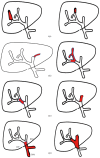Radiotherapy as valid modality for hepatocellular carcinoma with portal vein tumor thrombosis
- PMID: 27570422
- PMCID: PMC4974584
- DOI: 10.3748/wjg.v22.i30.6851
Radiotherapy as valid modality for hepatocellular carcinoma with portal vein tumor thrombosis
Abstract
Although the current standard treatment for hepatocellular carcinoma (HCC) with portal vein tumor thrombosis (PVTT) is sorafenib, many previous studies have established the need for a reliable local modality for PVTT control, which is a major cause of liver function deterioration and metastasis. Additionally, there is growing evidence for the prognostic significance of PVTT classification according to the location of tumor thrombosis. Favorable outcomes can be obtained by applying local modalities, including surgery or transarterial chemoembolization, especially in second-order or distal branch PVTT. Rapid control of PVTT could maintain or improve liver function and reduce intrahepatic as well as distant metastasis. Radiotherapy (RT) is one of the main locoregional treatment modalities in oncologic fields, but has rarely been used in HCC because of concerns regarding hepatic toxicity. However, with the development of advanced techniques, RT has been increasingly applied in HCC management. Randomized studies have yet to definitively prove the benefit of RT, but several comparative studies have justified the application of RT in HCC. The value of RT is especially noticeable in HCC with PVTT; several prospective and retrospective studies have reported favorable outcomes, including a 40% to 60% objective response rate and median overall survival of 15 mo to 20 mo in responders. In this review, we evaluate the role of RT as an alternative local modality in HCC with PVTT.
Keywords: Alternative; Hepatocellular carcinoma; Local modality; Portal vein tumor thrombosis; Radiotherapy.
Figures



Similar articles
-
Treatment of hepatocellular carcinoma with portal venous tumor thrombosis: A comprehensive review.World J Gastroenterol. 2016 Jan 7;22(1):407-16. doi: 10.3748/wjg.v22.i1.407. World J Gastroenterol. 2016. PMID: 26755886 Free PMC article. Review.
-
Survival outcomes of hepatic resection compared with transarterial chemoembolization or sorafenib for hepatocellular carcinoma with portal vein tumor thrombosis.Clin Mol Hepatol. 2016 Mar;22(1):160-7. doi: 10.3350/cmh.2016.22.1.160. Epub 2016 Mar 28. Clin Mol Hepatol. 2016. PMID: 27044767 Free PMC article.
-
Radiotherapeutic strategies for hepatocellular carcinoma with portal vein tumour thrombosis in a hepatitis B endemic area.Liver Int. 2017 Jan;37(1):90-100. doi: 10.1111/liv.13191. Epub 2016 Jul 12. Liver Int. 2017. PMID: 27317941
-
Comparison of chemoembolization with and without radiation therapy and sorafenib for advanced hepatocellular carcinoma with portal vein tumor thrombosis: a propensity score analysis.J Vasc Interv Radiol. 2015 Mar;26(3):320-9.e6. doi: 10.1016/j.jvir.2014.10.019. Epub 2015 Jan 19. J Vasc Interv Radiol. 2015. PMID: 25612807
-
Management of hepatocellular carcinoma patients with portal vein tumor thrombosis: A narrative review.Hepatobiliary Pancreat Dis Int. 2022 Apr;21(2):134-144. doi: 10.1016/j.hbpd.2021.12.004. Epub 2021 Dec 16. Hepatobiliary Pancreat Dis Int. 2022. PMID: 34955380 Review.
Cited by
-
The Progress in the Treatment of Hepatocellular Carcinoma With Portal Vein Tumor Thrombus.Front Oncol. 2021 Sep 23;11:635731. doi: 10.3389/fonc.2021.635731. eCollection 2021. Front Oncol. 2021. PMID: 34631513 Free PMC article. Review.
-
Evaluation of the Efficacy and Toxicity of Radiotherapy for Type III-IV Portal Vein Tumor Thrombi.Technol Cancer Res Treat. 2021 Jan-Dec;20:1533033821995286. doi: 10.1177/1533033821995286. Technol Cancer Res Treat. 2021. PMID: 33590809 Free PMC article.
-
Sequential bilateral PVTT successfully controlled by radiotherapy and sorafenib, respectively.Kaohsiung J Med Sci. 2019 Jan;35(1):63-64. doi: 10.1016/j.kjms.2018.06.003. Kaohsiung J Med Sci. 2019. PMID: 30844140 Free PMC article. No abstract available.
-
Comparison of Treatment Response, Survival Profiles, as Well as Safety Profiles Between CalliSpheres® Microsphere Transarterial Chemoembolization and Conventional Transarterial Chemoembolization in Huge Hepatocellular Carcinoma.Front Oncol. 2022 Jan 21;11:793581. doi: 10.3389/fonc.2021.793581. eCollection 2021. Front Oncol. 2022. PMID: 35127501 Free PMC article.
-
Optimizing radiotherapy with immune checkpoint blockade in hepatocellular carcinoma.World J Gastroenterol. 2019 May 28;25(20):2416-2429. doi: 10.3748/wjg.v25.i20.2416. World J Gastroenterol. 2019. PMID: 31171886 Free PMC article. Review.
References
-
- El-Serag HB, Rudolph KL. Hepatocellular carcinoma: epidemiology and molecular carcinogenesis. Gastroenterology. 2007;132:2557–2576. - PubMed
-
- Siegel RL, Miller KD, Jemal A. Cancer statistics, 2016. CA Cancer J Clin. 2016;66:7–30. - PubMed
-
- Chang TT, Liaw YF, Wu SS, Schiff E, Han KH, Lai CL, Safadi R, Lee SS, Halota W, Goodman Z, et al. Long-term entecavir therapy results in the reversal of fibrosis/cirrhosis and continued histological improvement in patients with chronic hepatitis B. Hepatology. 2010;52:886–893. - PubMed
-
- Sun P, Yang X, He RQ, Hu QG, Song ZF, Xiong J, Zheng QC. Antiviral therapy after curative treatment of hepatitis B/C virus-related hepatocellular carcinoma: A systematic review of randomized trials. Hepatol Res. 2014;44:259–269. - PubMed
-
- Yin J, Li N, Han Y, Xue J, Deng Y, Shi J, Guo W, Zhang H, Wang H, Cheng S, et al. Effect of antiviral treatment with nucleotide/nucleoside analogs on postoperative prognosis of hepatitis B virus-related hepatocellular carcinoma: a two-stage longitudinal clinical study. J Clin Oncol. 2013;31:3647–3655. - PubMed
Publication types
MeSH terms
LinkOut - more resources
Full Text Sources
Other Literature Sources
Medical

